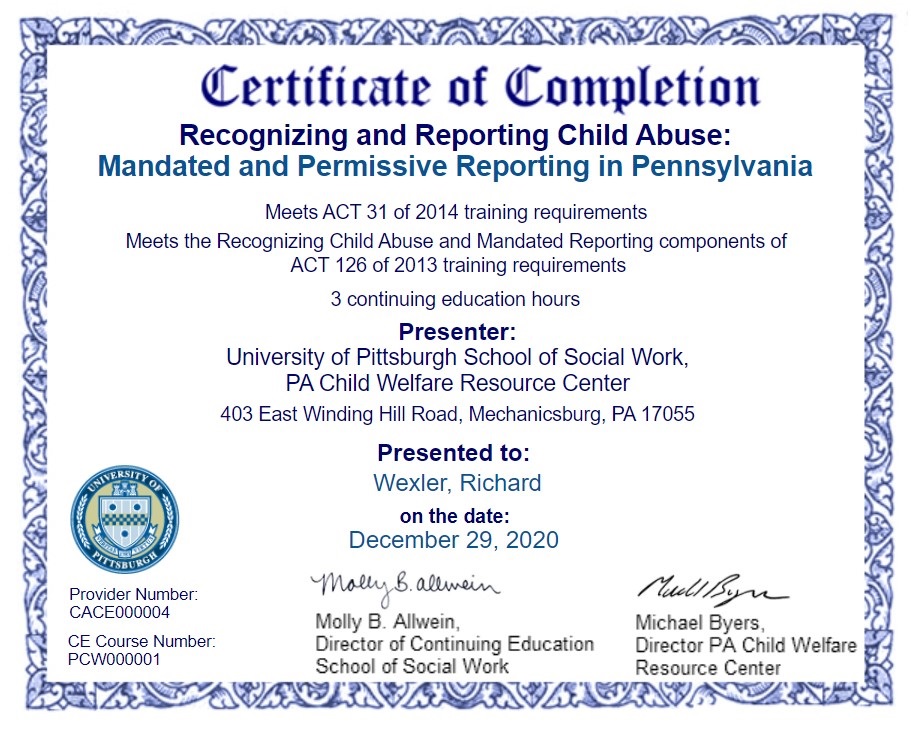 DUNCAN CUTHBERTSON/SHUTTERSTOCK
DUNCAN CUTHBERTSON/SHUTTERSTOCK
It was a tough year. Perhaps at some point your child became more aggressive or more anxious or more mistrustful or more prone to seek attention — or more withdrawn or more passive or too compliant. Maybe he flinches easily and avoids being touched. Maybe he just doesn’t get along with his peers. Maybe he feels very tired. Maybe he depends too much on adults. Or maybe he’s just not acting his age.
How about you? Are you socially isolated? Are you physically disabled? Emotionally challenged? Are you more stressed and anxious? Are you more frustrated or impatient? Does your mood change suddenly? Are you impulsive? Do you have issues with authority? Are you feeling emotionally insecure? Do you lack organizational skills?

Richard Wexler
I don’t mean to get personal. In fact, it’s hard to imagine any adult or child who hasn’t experienced at least one of these things over the past year — even if you don’t include “avoids being touched” and “socially isolated.” I only ask because in at least one state, Pennsylvania, even one of these “signs” or “risk factors” is enough to put you on the radar to possibly be reported to ChildLine, the state’s child abuse hotline, as a child abuser.
Every one of these “signs” and “risk factors” is included in a training course for professionals in Pennsylvania who are “mandated reporters” of child abuse. In Pennsylvania, as in many states, that’s almost anyone with regular contact with children — including the very people you might reach out to for help if you or you or your child really is experiencing these problems.
I’ve previously discussed the research on the obvious dilemma this creates for families, and the research showing that mandated reporting itself has backfired and should be abolished. Here, I want to share how some mandated reporters are trained.
Most mandated reporters have to take such a course. Nationwide, the number of such reporters runs well into the millions. I took the Pennsylvania course because I’m a member of a committee named by the Philadelphia City Council to examine the way the city takes children from their parents — something it does at one of the highest rates among America’s biggest cities.
I chose this particular course because it’s free, it’s online and anyone can take it. (What appears to be the full text, minus illustrations, also is available here.) Nearly 300,000 people took the course in state fiscal year 2019.
The course isn’t really training; it’s an exercise in propaganda and paranoia designed to encourage you to report based on little more than “feelings” or “gut instinct” and one of those broad, vague “signs” or “risk factors.” It exaggerates the expertise of those who will handle the report and repeatedly implies that while terrible harm can come from failing to report, nothing will go wrong if you report an innocent family by mistake.
The heart of the problem: Balance of harms
At its core, the problem with the Pennsylvania indoctrination course is the problem with our entire approach to child welfare: It flunks the balance of harms test.
The family policing system (a more accurate term than “child welfare” system) is built on the premise that catastrophe might follow if you don’t report, or if the report isn’t investigated or if the child isn’t removed from the home.
That is, almost literally, a half-truth. But here’s the other half: It also is true that terrible things can happen if you report an innocent family, if the child is traumatized by the investigation, if the family is placed on a blacklist that can drive them deeper into poverty, and, especially, if the children are consigned to the chaos of foster care. Those terrible things can include the high rate of abuse in foster care itself.
The course ignores all this in favor of sending just one message over and over and over: Report! Report! Report!
The message is summed up in a slide that begins with the question: “But if I report could that make things worse?”
The course replies:
“Report to ChildLine. You only need reasonable cause to suspect that a child is a victim of abuse. The consequences of not reporting your concerns could seriously endanger a child’s safety or even put a child’s life at risk.”
Again, this message is, almost literally, a half-truth. Yes, the consequences of not reporting your concerns could seriously endanger a child’s safety or even put a child’s life at risk. But there is no acknowledgment that terrible things also can happen — up to and including putting a child’s life at risk — if you do report and get it wrong.
You also will be told, repeatedly, that “Once a report is received, specially-trained child welfare professionals determine whether the child is a victim of abuse and what action is necessary to ensure a child’s safety or well-being.”
The course implies that those “specially-trained child welfare professionals” will follow “Pennsylvania’s Child Welfare Practice Model.” A slide summarizing the model includes one bullet point after another about supporting and strengthening families — and not one word about taking away the children.
In fact, if one didn’t know better one might slog through the entire course and never realize that the call could result in a child being taken away. It is perhaps a testament to the extent to which we’ve all caught on to the harm of needless foster care that the designers of this course barely dare to speak its name.
As for “specially trained child welfare professionals,” once again, sometimes that’s true. But in Pennsylvania it’s also possible that the person sent out as a result of your report could be someone who just graduated college with a degree in English literature, has 12 credits of gerontology and got 10 to 12 weeks of training before making life-and-death decisions for children and families. In many cases, the person forced to report may be more qualified to know if a child is in danger and needs the coercive intervention of the family police than the not-so-specially trained caseworker sent out to investigate.

Confusing poverty with neglect
The Pennsylvania mandated reporter training course repeatedly encourages the confusion of poverty with “neglect.”
That list of “signs” of a child being abused or neglected also includes lack of adequate medical and dental care (the latter may be a particularly dangerous thing to stress in Pennsylvania), lack of shelter and dirty clothing. And while some warning signs apply to only one form of maltreatment, “economic stress” is considered a “sign” that the parent may be physically abusing, sexually abusing, mentally abusing and/or neglecting a child. It’s the all-purpose red flag!
Perhaps that’s why a Pennsylvania school district threatened to report parents who owed money for their children’s school lunches.
This is followed almost immediately by a video on how enormously devastating neglect can be. In some cases, of course, it can. But combining this video with conflating poverty with neglect only increases the chance of inflicting genuinely devastating emotional trauma of a needless child abuse investigation and needless removal to foster care. Another video compounds the problem, reinforcing the discredited “medical model” suggesting that all neglect is the result of some kind of mental health problem, with almost no acknowledgment that the problem often is poverty and the solution often is money.
Of course, there is a boilerplate warning that sometimes children actually experience these “signs” and “risk factors” even when they’re not abused — but also beware! Children can be abused and parents can be abusers even if none of these signs is present.
This is reinforced by two hypothetical scenarios. In one we’re told to report a mother who “has been known to” leave her young children unattended while they all live in a homeless shelter. There is no comparable scenario for someone who “has been known to” leave her young children alone in their McMansion. Another case supports turning in a mother who “occasionally leaves for work a couple of hours before her nine-year-old son gets picked up for school.” (Here’s a tip if you have to take the course: No matter what the scenario, if they ask whether you should report it, say yes.)
Reasonable cause to suspect
Pennsylvania law requires mandated reporters to call ChildLine when they have “reasonable cause to suspect” abuse or neglect. But the legislature never defined “reasonable cause to suspect.” So it means whatever local authorities want it to mean.
Nothing in state law says the mere fact of a sports injury is “reasonable cause to suspect” abuse. But at Children’s Hospital of Philadelphia a social worker reportedly told an Asian-American father whose child was injured while he taught the boy judo that she typically reports all sports injuries. (The father, City Councilmember David Oh, was cleared. He persuaded his colleagues to create the advisory committee on which I now serve.)
The then-commissioner of the city’s child protective services agency, Cynthia Figueroa, not only had no problem with this, she reportedly encouraged people to “follow their intuition” when deciding whether to report. The problem with this should be obvious, but in case it’s not: Imagine the uproar if a police commissioner said: “If you see a Black man walking through your white neighborhood and your ‘intuition’ says he’s up to no good, call us!”
In any context involving race and class, “intuition” is another word for bias and “feelings” is a nice way of saying prejudices. But not only does Pennsylvania’s mandated reporter course not counter this invitation to bias — it encourages it. In determining if you have “reasonable cause to suspect,” the training specifically says to consider “gut feelings.” Elsewhere a graphic lists the components of “reasonable cause to suspect” as “the circumstances, your observations, your familiarity with the people and situation and your feelings and beliefs.”
Tokenism
Of course, the training doesn’t ignore bias completely. The part about feelings includes one entire slide warning that “biases and stereotypes” can influence conclusions. And there’s an entire nine-minute video which, while almost entirely avoiding so much as using the word racism, does warn you that bias exists and you might actually have some. The solution: Ask yourself if you might be biased! Rate your own “cultural competence” on a scale of 1 to 10! If only we’d known before that this is all it takes to overcome 400 years of American racism.
Even this video doesn’t really want you to curb those “gut instincts.” At the beginning, as we see pictures of adorable kids pointing right at you, the narrator says “YOU may be a vulnerable child’s first defense against ongoing victimization.” At the end, after suggesting that you, in effect, second-guess yourself, the video turns around and says that if you have “reasonable cause to suspect” — whatever that is — then “never second guess yourself” and call in that report!
But the Pennsylvania Department of Human Services actually cites this exercise in tokenism as evidence of how much they really, truly care about curbing racial bias in child welfare.
The right message
Judging by the messaging to the general public from family policing agencies all over the country, this course probably is typical. Even were mandated reporting abolished — as it should be — there still would be a need for some sort of training since everyone is permitted to report.
A good training curriculum would acknowledge that, while sometimes these decisions should be easy, in many more cases they are hard, and a wrong decision either way can be tragic. A good training curriculum would be as specific as possible about what to report, and what not to report. A good training curriculum would offer a concrete definition of “reasonable cause to suspect” with examples of what does — and does not — meet that criterion. A good training course would warn against reporting based on “intuition” or “gut instinct” or “feelings.” A good training curriculum would include an entire course on racial and class bias — and that course wouldn’t shy away from using the word “racism.”
And one more thing: In order to illustrate the issue of balance-of-harms, a good training curriculum would include one more video: This one. It’s almost eight minutes of anguished children crying for their parents. They were torn from those parents at the border due to the Trump administration’s “zero-tolerance” policy.
Of course there’s a difference between that and what U.S. family policing agencies do: The domestic family police almost always mean well. But the trauma for the children is the same. If we’re supposed to decide whether to put children at risk of such separation based on our “gut feelings” then we all could all use that kind of gut check.
Richard Wexler is executive director of the National Coalition for Child Protection Reform.































